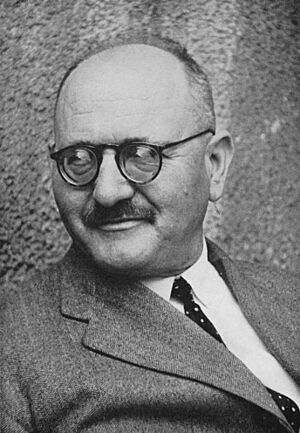Andrija Štampar facts for kids
Quick facts for kids
Andrija Štampar
|
|
|---|---|

Štampar in 1939
|
|
| Born | 1 September 1888 Brodski Drenovac, Kingdom of Croatia-Slavonia, Austria-Hungary |
| Died | 26 June 1958 (aged 69) Zagreb, PR Croatia, FPR Yugoslavia |
| Occupation | Physician |
| Nationality | Croatian |
| Notable awards | Leon Bernard Foundation Prize and Medal 1955 |
| Signature | |
Andrija Štampar (born September 1, 1888 – died June 26, 1958) was a very important doctor from Croatia. He was known for his work in social medicine, which focuses on how society and daily life affect people's health. He believed that everyone should have access to good healthcare.
Contents
Early Life and Education
Andrija Štampar was born in a place called Brodski Drenovac in 1888. This area was part of the Austro-Hungarian Empire back then. From 1898 to 1906, he went to grammar school in Vinkovci. He was a very smart student. Even when he was young, he wrote articles about health. His first writing was published in a magazine called Pobratim in 1902.
In 1906, he started studying medicine in Vienna, Austria. At that time, Vienna was one of the best places in the world to study medicine. As a student, he began writing more articles and small books to teach people about health and how to prevent illnesses. In 1909, he started a series called Public Health Library. It covered many health topics. On December 23, 1911, he officially became a doctor.
Career and Public Health Work
After becoming a doctor, Štampar started working at a hospital in Karlovac in 1912. He also joined the Croatian Medical Association, a group for doctors. He wrote several articles for their journal.
In 1913, he became a district health officer in Nova Gradiška. This job allowed him to help organize health services for a whole area. In 1919, he went to a big meeting in Paris about social hygiene. He gave a speech about children's health. It was clear even then that he had great ideas for how to set up public health services. People often called Andrija Štampar "the man of action" because he was always busy making things happen.
When he was 31, he became the head of the Department of Public Health in Belgrade. Thanks to his hard work, a special Institute of Social Medicine was created at the University of Zagreb School of Medicine. From 1924, he was part of many international groups of experts. Through his efforts, these groups received money from the Rockefeller Foundation to help with health projects.
In 1930, his work at the Ministry of Public Health was stopped by King Alexander. The King wanted Štampar to join his government as a minister, but Štampar refused. He believed in free elections and wouldn't join the government without them. Because of this, he was forced to retire in 1931.
Working Around the World
From 1931 to 1933, Štampar worked as an expert for the Health Organization of the League of Nations. This was a new kind of work for him. He traveled a lot, gave many lectures, and learned about health problems all over the world.
- United States and Canada: From October 1931 to January 1932, Štampar visited the United States and Canada. He was a guest of the Rockefeller Foundation. The League of Nations also asked him to study how much medical care cost in America.
- China: From 1933 to 1936, he spent time in China. The Health Organization sent him there to help the Chinese government control serious diseases. These diseases had spread after terrible floods in 1931. A Chinese official named Ching Feng wrote about Štampar's work, saying he made a valuable contribution to improving health in their villages.
- Geneva and Harvard: In 1936, he was offered a job as an expert at the Health Organization in Geneva. In 1938, he was invited to Harvard University in Boston, where he gave a lecture. After Boston, he traveled across North America. He gave talks on hygiene and social medicine at many universities, including Yale, Cornell, and Columbia.
In 1946, a big meeting called the International Health Conference was held in New York. Representatives from 51 countries attended. They created the plan for the World Health Organization (WHO). The first meeting of the WHO was held in Geneva in 1948. Štampar was chosen as the first president of this important assembly. In 1955, at a WHO meeting in Mexico City, Štampar received the Leon Bernard Foundation Prize and Medal. This is the highest international award for achievements in social medicine.
A statue of Štampar was even built in Morocco. This was to honor his work in helping to cure malaria there.
Return to Zagreb
Andrija Štampar founded the School of Public Health in Zagreb in 1927. This school was very important for training health workers.
In 1939, after many years, he finally became a full professor of hygiene and social medicine at Zagreb University. He was also chosen to be the dean of the medical school for the 1940/41 school year. With his usual energy, he worked to improve medical training.
During World War II, Štampar was arrested by the police in Zagreb. He was later arrested again by German police and sent to a prison in Graz, Austria. He was held there until the Soviet army arrived in 1945. When he returned in May 1945, he went back to his job as a professor. He also became the head of the School of Public Health in Zagreb again.
Štampar was the rector (the head) of Zagreb University for the 1945/46 school year. In 1952, he was chosen as the dean of the medical school again, serving for five years in a row. He also played a big part in starting the medical school in Rijeka in 1955.
Images for kids
See Also
- World Health Organization
- Social medicine


